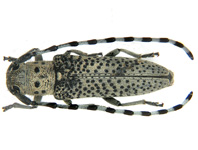Abstract
Tokophrya species are either free-living or facultative ectosymbiotic suctorians associated with copepods, isopods, mysids, decapods and amphipods. Tokophrya huangmeiensis in particular is found to be epizoic with the redclaw crayfish Cherax quadricarinatus Von Martens, 1868, which has been observed as part of an ongoing investigation of freshwater ciliates biodiversity in Huanggang, Hubei, China (Tahir et al. 2017). This first study on T. huangmeiensis based on morphological features using light microscopy and small subunit ribosomal DNA sequence (Tahir et al. 2017), suggested that more detailed descriptions on the physiological and structural changes of this species should be done. Thus, in this study, we looked at the ultrastructures of T. huangmeiensis using electron microscopy, including both scanning (SEM) and transmission electron microscopy (TEM).
References
Bardele, C.F. (1970) Budding and metamorphosis in Acineta tuberosa . An electron microscopic study on morphogenesis in Suctoria. Journal of Protozoology, 17, 51–70.
https://doi.org/10.1111/j.1550-7408.1970.tb05158.xGuilcher, Y. (1951) Contribution à l’ étude des ciliés gemmipsres, chonotriches, et tentaculiféres. Annales des Sciences Naturelles Zoologie, 11 (8), 33–115.
Lynn, D.H. (2007) The Ciliated Protozoa. Springer Science, Dordrecht, 549 pp.
Millecchia, L.L. & Rudzinska, M.A. (1970) The ultrastructure of brood pouch formation in Tokophrya infusionum. Journal of Protozoology, 17, 574–583.
https://doi.org/10.1111/j.1550-7408.1970.tb04731.xRudzinska, M.A. (1965) The fine structure and function of the tentacle in Tokophrya infusionum. Journal of Cell Biology, 25 (3), 459–477.
https://doi.org/10.1083/jcb.25.3.459Rudzinska, M.A. & Porter, K.R. (1954) Electron microscope study of intact tentacles and disc in Tokophrya infusionum. Experientia, 10 (11), 460–462.
https://doi.org/10.1007/BF02170400Tahir, U.B., Qiong, D., Sen, L., Yang, L., Zhe, W. & Zemao, G. (2017) First record of a new epibionts suctorian ciliate Tokophrya huangmeiensis sp. n. (Ciliophora, Phyllopharyngea) from redclaw crayfish Cherax quadricarinatus von Martens 1868. Zootaxa, 4269 (2), 287–295.
https://doi.org/10.11646/zootaxa.4269.2.7Tilney, L.G. (1968) The assembly of microtubules and their role in the development of cell form. Developmental Biology, 2, 63.
https://doi.org/10.1016/B978-0-12-395711-5.50010-4

